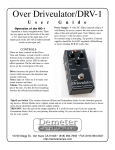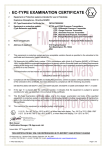Download Fender TGA-3 Stereo Amplifier User Manual
Transcript
15730 Stagg Street | Van Nuys, CA 91406 | 818-994-7658 | http://www.demeteramps.com/ TGA-3 100 Watt Guitar Amplifier User’s Guide INTRODUCTION Congratulations! You’ve just purchased one of the finest, best-sounding and most versatile amps on this planet! Please be patient and read this manual before you power-up, and you will be richly rewarded. OVERVIEW The Demeter TGA-3 was designed by James Demeter as literally three amps in one. Therefore, a basic explanation of the front panel controls and rear panel jacks is necessary to enable you to unlock the great potential of this professional tool. Looking at the front control panel, there are four colors of knobs: yellow, green, red, and blue. The blue knobs are controls which are common to all channels: stereo effect returns and the presence control. We’ll talk more about these later on. The yellow knobs control the “clean” channel, reminiscent of a vintage Fender Deluxe or Bassman. This channel is capable of delivering plenty of squeaky-clean volume for country or traditional Jazz styles. It also has a great blues “bite” to it when you turn up the gain, similar to a Tweed Fender Deluxe with everything on “10.” The green and red overdrive channels give you every possible combination of distortion, feedback and sustain. From smooth to hard, from Vintage British Crunch to “ modded” super distortion, this amp has it all and more. Rear Panel Before you turn on the amp, let’s take a look at the rear panel, where you will make the proper connections to your system. Speakers No tube amp should be powered up without making sure that the speakers are connected. If you have a TGA-3100 combo amp the speaker will come connected, but it is always a good idea to check anyway. A tube amp can burn up its output transformer (an expensive repair) if operated without being connected to a speaker. Impedance Always obser ve proper impedance matching. The Demeter TGA-3-100 has 3 speaker output jacks: for 4, 8 and 16 ohm cabinets. If you don’t know what the impedance of your speaker cabinet is, you should find out! If your cabinet or speaker is not marked (most are), you can try the following: Connect an ohmmeter bet ween the terminals or to the input jack of the cabinet, and set the meter’s range for at least 20 ohms full-scale. The reading will usually be a bit less than the actual impedance (6 or 7 ohms for an 8- ohm speaker, 3 or 3.5 ohms for a 4- ohm speaker, 13 to 15 ohms for a 16 ohm speaker). Impedance matching is necessary to get optimum volume and tone, and to avoid undue stress on your amp. Note: most Marshall-type cabinets will have an impedance of 16 ohms, but some may be wired for 4 ohms. 15730 Stagg Street | Van Nuys, CA 91406 | 818-994-7658 | http://www.demeteramps.com/ TGA-3 100 Watt Guitar Amplifier User’s Guide Speaker Combining A word about speaker combining: as mentioned earlier, there are 3 speaker outputs on the rear panel, labeled 4, 8, and 16 (ohms). When connecting one speaker cabinet to the amp, you can choose one of the three jacks for proper impedance matching. When connecting a “full stack”, or multiple cabs, you should first determine the impedance of each cab, then calculate the total impedance of the stack. This is very simple to do when using t wo identical cabs with the same impedances. Simply divide the cab’s ohms by 2, and use the next smaller valued jack for the second cab, or plug one cab into another (if you can) and go into the 4 ohm jack only. Example: If you have 2 Marshall-type 4X12’s at 16 ohms each, plug one into the 16 ohm jack and one into the 8 ohm jack. If you’re running t wo Fender-type 2X15 or 2X12 cabs, or equivalent, at 8 ohms each, use the 8 ohm and 4 ohm jacks, or plug one into the other and use 4 ohm. Impedance Formula With differing impedances, or more than t wo cabs (not recommended), it is a bit more complex. The formula for calculating parallel resistances works in this situation, and is as follows: RT = ____1_______________ __1__ + __1__ + __1__ + . . . . R1 R2 R3 or, ____1____ = __1__ + __1__ + __1__ + . . . . RT R1 R2 R3 Or you can take my word for it, this means if you combine more than t wo speakers with low impedance, the figure becomes too low to use with this amp. Examples: 4 8-ohm speakers, when chained together have a total impedance of 2 ohms, and 2 ohms is too low. Conversely, a 16- ohm Marshall cab combined with one wired for 4 ohms equals about 8 ohms. Wire cabs together and plug into 8 ohms, or plug one into 16 ohm and one into 4 ohm. Two t win-12 or t win-15 Fender cabs, usually 8 ohms each, equal 4 ohms. Plug one cab into the 8 ohm jack and one into 4 ohm, or chain together and go into 4 ohm. Loading Note: this amp should always be connected to a load, even if you are using it as a “preamp.” You can come out of the slave amp output jack (on the rear panel), but only if this amp is connected to a speaker, or what is known as a “dummy” load. This is a large resistor, 8 or 16 ohms, mounted in an insulated box with a heat sink, which has a wattage rating of 100 watts or better. A “power soak” (speaker emulator) or “power attenuator” is not always a dummy load. Although not recommended, this scheme will work. Remember, power attenuators, which work with the amp fully “cranked”, will shorten the life of your tubes. 15730 Stagg Street | Van Nuys, CA 91406 | 818-994-7658 | http://www.demeteramps.com/ TGA-3 100 Watt Guitar Amplifier User’s Guide Tube Type Switch (Autobiasing) Returning to the rear panel, to the left of the speaker jacks, you will notice a switch labeled tube type. This switch has t wo positions for three different kinds of output tubes. The Demeter has a state of the art feature known as auto-biasing, which allows you to get even more variation of sound by changing the output tubes (the big ones). There are three popular tubes presently in use for this amp. The 6L6 (5881) of the large Fenders, with it warm harmonic richness; the 6CA7 (EL34) of the vintage Marshall, with its smooth sustained distortion; and the 6550 of the ‘American’ Marshall and SVT, with extra power and Heavy-Metal ‘Crunch’. When the tube type switch is in 5881 position, the Demeter will automatically select the proper bias of 5881 or 6550 tubes. The other position is for 6CA7’s (EL34). Incidentally, this amp does not require matched sets of specially graded tubes for best performance, just make sure the tube type switch is properly set when you change your tubes: usually once every six months to once a year, depending on use. 1/2 Power Switch To the right of the speaker jacks there is a switch marked 1/2 power/full power. This cuts off t wo output tubes to obtain full output and distortion at a lower level (turn off amp before switching this). Output Balance To the left of the speaker jacks is a small adjustment screw labeled output balance, To adjust, turn the amp on with nothing plugged in but the speaker, and listen to the amp “idle”. With a screwdriver, rotate the control clockwise and counter-clockwise until you find the spot where the hum disappears. This fine- tuning will insure the best signal to noise ratio, and should usually be performed when changing or installing new output tubes, or after several month’s usage. Effects Loop The effects loop of the TGA-3-100 is tube-buffered. This means that it will probably match the impedances of your effects. Looking to the right of the 1/2 power switch, we come to the stereo effects loop jacks. This loop is designed for a mono send, and a stereo or mono return. If you are using effects, the following will apply. Note: since there is little standardization of minimum and maximum signal levels bet ween manufacturers of semipro and professional effect units, this amp has a very wide range of effect-loop gain. Make sure you don’t have your effect’s input level set too high (in the red). Also, if you are using guitar “stompboxes”, which generally do not have level controls, it is usually necessary to run the effects send control at a very low level. If you have boxes which are still overloading, try putting a 10dB pad on the effects send or the input of your effect. 15730 Stagg Street | Van Nuys, CA 91406 | 818-994-7658 | http://www.demeteramps.com/ TGA-3 100 Watt Guitar Amplifier User’s Guide Effects Loop Controls The front panel controls for the effects loop are: FX send/submaster (yellow for channel 1 and red for channels 2 and 3), the stereo FX loop returns (blue). The input and output level controls and switches of your effects unit(s) must also be set properly. If your effect has a gain or level switch, it is best to set it to high, line level, or +4dB. Next, set the FX send/submaster controls for channel 1 and channel 2-3 to 12 o’clock. Connect the input to send and the output to return. Start with your effect’s input level down and, when you power-up, adjust the level of your effect to stay ‘out of the red’. Turning up the stereo FX loop returns, left and right, will affect the overall amp volume (more on these controls later in this manual). Note: The Demeter has a lot of attack transient response, and responds dynamically to picking strength and pickup volume. The input level meters (or VU’s) on some effects are too slow to read your guitar’s transient attack, which can be t wice as loud as the sustain. If you experience unmusical distortion or ‘break-up’ of the signal, and the input level is ‘in the green’ try backing off the input level a notch or t wo or, turn down the FX send/submaster a bit, to make sure you really have sufficient headroom. Slave Amp Output To the right of the stereo return jack is one marked output to slave amp. This is for true stereo operation with another power amplifier. The TGA-3-100 will work well in stereo with another high quality guitar power amplifier. However, to achieve true matched stereo sound, we recommend the Demeter STGA-1 for most balanced tone and output, without redundant controls. The TGA-3-100 becomes the master control for both amplifiers in stereo mode, with the (blue) stereo FX loop return, right channel, controlling the volume of the slaved amplifier. The slave amp output also can double as a line out to a miking board or sound system. Rear Extra Input To the right of the slave out is an accessory/extra input for convenience when rack-mounting the TGA3-100 (a rack-mounting kit is available). Both inputs can be used simultaneously, and both share the same input channel. Footswitch Operation Further right are the footswitch jacks. Provisions are made for both ‘conventional’ footswitches (latched grounding type) and the optional FS-1 footswitch with tricolor L.E.D. indicators. The FS-1 connects to the 5pin XLR jack on the far right of the rear panel. The switching method is compatible with most MIDI switching boxes, such as the Rockman MIDI Octopus, etc. Channel switching can also be done from the front panel by using the 3- position rocker switch on the far left. Note: this switch should be in the center position when using any footswitches. The footswitches work as follows: t wo latched, grounding-type foot switches are connected to the t wo channel switching jacks, one labeled clean, the other dirty/edge. When the clean switch is on the amp is in channel 1 and the other switch has no effect. The dirty/edge switch toggles bet ween channels 2 and 3, so switching the clean channel off gives you what ever setting you have preset with the other switch. This way, you have three preset sounds and volume levels from t wo switches. This makes very wide dynamic changes possible in a single move. The FS-1 footswitch works identically, but has a yellow and a red-green L.E.D. to indicate status. It combines both the footswitches in a single box. 15730 Stagg Street | Van Nuys, CA 91406 | 818-994-7658 | http://www.demeteramps.com/ TGA-3 100 Watt Guitar Amplifier User’s Guide Front Panel (Yellow Channel Tones) The front panel is color coordinated with the FS-1. The clean channel 1 (yellow) is on the bottom row, with a channel gain and master volume, and treble, middle and bass controls. Channel 1 has the sound of a Fender amp, but with more gain control. Using this channel with the gain set to the left of 12 o’clock produces clean tones with little or no distortion. As 12 o’clock it is crossed, a vintage- type ‘bite’ is added, increasing to a rich ‘blues’ tone like the old ‘Deluxe’ (use of 6550 tubes will give the amp more headroom for an even cleaner sound). This channel has it’s own FX send/submaster (note that the red channel is also configured this way). Bright Switch To the left of the gain control knob is the bright switch, which functions in a manner similar to most Fenders, but with less added noise. The front input is to the left of the bright, and to the far left is the channel select switch. Green Channel Above the yellow channel 1 are the green and red channels, 2 and 3. These t wo overdrive channels share the same tone controls: treble, middle and bass. Channels t wo and three (green & red) are variations of the same basic overdrive architecture; it’s like having a high-performance engine with t wo superchargers. As you become accustomed to the amp, you will set the gain and master controls of each channel for smooth or radical channel transitions. Edge/Boost Switch To the left of the green channel’s gain is the edge/lead switch. When set to edge this control changes the gain structure of the amp to behave like a vintage premaster volume Marshall. With the gain control or your guitar volume, it’s possible to govern the amount of edge distortion. The lead mode incorporates a more ‘modified Marshall’ type of distortion, with an added volume boost for more dynamic change from rhythm to lead. Careful adjustment of the gain, master and tone controls will produce the full gamut of British sounds, including ‘Hiwatt’ and ‘AC-30’-like tones. Again, try different output tubes for still more variation. Red Channel The red channel three, with it’s extreme feedback and sustain, goes beyond channel 2’s distortion for more modern sounds: Heavy Metal, Jazz Fusion, The ‘Seattle’ Sound. This channel has a dark switch which emphasizes the lowend thump’ like the ‘bass boost’ Marshall mod. Like the ‘clean’ channel 1, there are red treble, mid, and bass knobs which also control the tone on the green channel t wo. Note: the dark switch also affects channel 2, though not as much. 15730 Stagg Street | Van Nuys, CA 91406 | 818-994-7658 | http://www.demeteramps.com/ TGA-3 100 Watt Guitar Amplifier User’s Guide Gain Switch The red channel also has an FX send/submaster. To the right of this control and the dark switch is the gain switch, marked hot and hotter. On the ‘hot’ setting, this cuts the gain and feedback down 12dB, for a more tightly-controlled sound. If it’s out-of-control you want, set it to ‘hotter’ for more feedback and harmonic sustain. At extreme volume settings, hotter will cause harmonics to feed back an octave higher. Remember: the gain switch, the dark switch, red tone controls, and FX send/submaster are common to channels 2 (green) and 3 (red). The edge/lead switch is for channel 2 only. FX Send/Submasters A word about the FX send/submasters: with or without effects, these controls act as t wo “second-master” volumes, and can be useful in lower-volume situations to get a more “cranked-up” tone. The interplay of the gain, master and FX send/submaster also makes subtle changes in the quality of the overdrive, and can help in the achievement of a “loud” sound when recording or miking cabs on stage. FX Loop Returns To the right of the (yellow) FX send/submaster are the (blue) stereo FX loop return controls, left and right. As previously mentioned, the right return also controls the volume of a slave amplifier, whether. When effects or an amp is connected to this circuit, the returns become another ‘s ubmaster’ control, with still more subtle changes in the ‘s ound’ possible. Presence Control Further right is the (blue) presence control, similar to the presence knob on Fender and Marshall amps. It gives overall brightness to all amp settings. Note: This control will make a small amount of noise when rotated. This is normal for this type of control, as in original “t weed” Fenders and “plexi” Marshalls. Power/Standby Furthest right are the standby and power switches. The arrangement is similar to a Fender, with a pilot LED for the power switch, Standby provides for instant power-up without warmup time, and keeps tube filaments hot for longer tube life. There you have it. Thank you for being patient and reading this manual. All that remains is for you to connect your speakers, make the necessary connections, and throw the switches. Start with the master volumes on low, then put everything else at 12 o’clock to preset your volumes. Then add tone and gain ‘to taste’! We encourage you to experiment! If you have any further questions, feel free to call us. Written by Michael Gabriel. Thanks to James Demeter, Mike Amundson and Bill Lay for editorial assistance.













